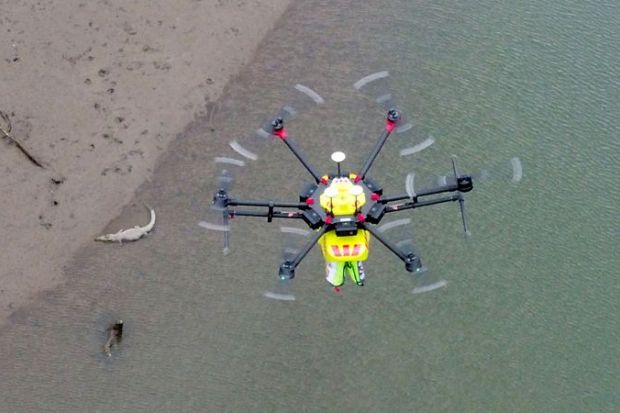An Australian university has harnessed one of the world’s newest technologies to detect one of its most ancient threats, in a technological breakthrough designed to protect people from saltwater crocodiles – and vice-versa.
Computer scientists from the University of Technology Sydney have developed artificial intelligence software capable of identifying the prehistoric predators – the world’s largest living reptiles, little changed from the Cretaceous period – from the air.
In a world-first demonstration, a drone fitted with the technology streamed live video of crocs in northern Queensland’s Mowbray River to the World of Drones Congress in Brisbane, over 1,000 miles to the south.
And in another breakthrough, the team reduced the “latency” of the footage – the time between its capture and its transmission to observers watching on a screen – from 10 seconds to less than one second.
Michael Blumenstein, who heads UTS’s Intelligent Drone Lab, said the reduced latency could mean the difference between life and death. He said the fast-moving drone could cover a lot of ground in 10 seconds, forcing the operator to turn the vehicle around and search again for whatever it had spotted.
“If you have someone in distress but the video feed is delayed, you won’t know there was someone there until it’s too late,” Professor Blumenstein said.
The UTS team developed SharkSpotter, a drone-based AI shark detection system now used at around 50 Australian beaches. The technology was named national machine learning innovation of the year in 2018.
But Professor Blumenstein said CrocSpotter, which was launched in Brisbane on 26 September, was a more challenging proposition. He said crocodiles’ habitats ranged from open ocean “where you can get relatively good contrast” to estuaries where the creatures blended in with their murky surroundings.
“Crocs have evolved since the dinosaur era to be brilliant at merging with their environment,” he said.
UTS said the CrocSpotter algorithm worked by “washing” the video and alerting drone operators to possible threats with flashing red boxes around images of detected animals. It said the algorithm had 93 per cent accuracy of identification compared to less than 20 per cent for the human eye.
The UTS team also developed the system to reduce the latency of the video stream from the drone camera, transmitted via the cloud, in a three-way collaboration involving the university, Amazon Web Services and drone operator Little Ripper.
The live-streamed demonstration detected some crocodiles but missed others in the muddy Mowbray River estuary north of Cairns. Professor Blumenstein said the “data hungry” technology would improve as a Queensland pilot of the system proceeded.
“We need to gather more data and scenarios to make sure we cover every possible environment that crocodiles live in,” he said. “That’s something we’re going to continue working on.
“This type of technology does not exist anywhere. You can’t purchase it off the shelf. For us as researchers, this is an amazing opportunity to test, improve and create technology for deployment.”
The safety need is considerable as saltwater crocodiles encroach increasingly into populated areas. The reptiles are extremely dangerous because, unlike most sharks, they deliberately target humans as prey.
Professor Blumenstein said the technology could also be harnessed to study crocodile behaviour, migration and population. “It all started with the safety aspect but there’s far more potential for the AI to be used to help people preserve marine life.”




